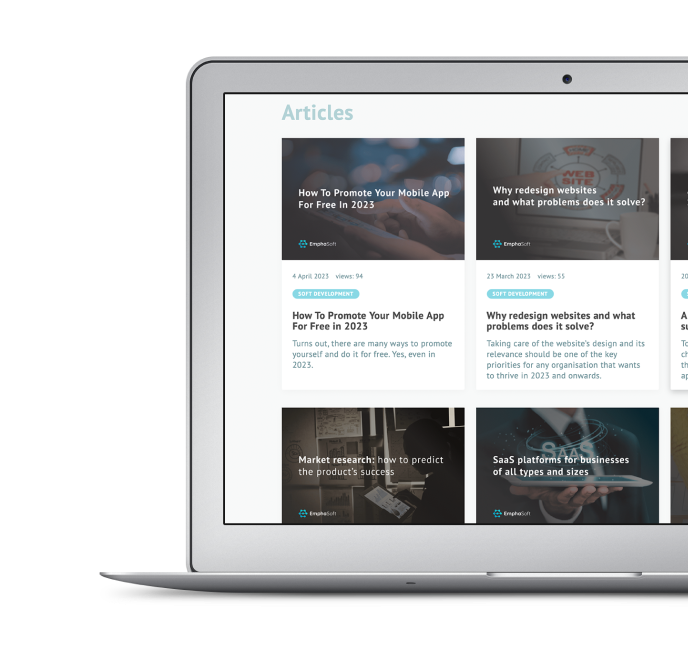It is difficult to overstate the meaning of a Company's website in today’s world when it is not only the calling card of the business but also a powerful marketing tool and a way to demonstrate reliability to the clients as well. It is very important to pay attention to the maintenance of your website and constantly check whether it is up to date. Once you have noticed some problems, you should consider a redesign. Of course, it can’t be called «one-size-fits-all solution». After all, if your website works efficiently and meets modern requirements, why should you change anything? Unfortunately, many companies cannot claim that. Let's try to figure out when a website redesign would be useful.
1. Your company has changed
Business development may require reviewing your brand and how you approach your clients. Making major changes in your business may mean your website still remains a reflection of your old conception. If you have recently rebranded, fundamentally modified your product or released a new one, or are focusing on a different target audience segment (younger or older for example), we recommend redesigning your website. You may also need to consider adopting a new marketing strategy. The main goal in all these cases is to create a unified image of your company.
2. Design and Technical Irrelevance
Like any marketing tools, websites become outdated after a while and may require visual updates and eliminating irrelevant solutions. According to current trends, your website should have a user-friendly structure and not distract with unnecessary sections. Obsolete elements (such as flash-content) must be removed because they can cause your website to slow down, frustrating potential customers. The contemporary design should not only be aesthetically pleasant, but also functional, and relevant to your target audience. It should accentuate important information and be convenient for users so they may easily find the answers for their requests.
3. Responsive Design Absence
It is no secret that a high percentage of people nowadays prefer to visit websites by mobile devices. These activities include searching for some information, online shopping, and using online services for hailing a taxi or ordering food. The necessity of a mobile version of a website seems obvious for everyone, yet we still find companies online ignoring this fact. The first thing you should think about if your website doesn't have responsive design is that every day you are losing a large number of customers who prefer using mobile devices to desktops. And besides, a lack of responsive design also indicates your website is old and needs to be updated.
4. A Lack Of Data Security
Since e-commerce became widespread, most websites collect and keep valuable information of thousand users. This has brought data security to the forefront of concerns for any company wishing to be seen as a reliable partner. Especially now when online scammers are using increasingly sophisticated methods. If it has been a while since your website has been updated or you have doubts about its security, it is time to make all required changes. These include redesigning your site to ensure the highest level of data security. These actions would not only reduce the risks of online fraud but also make your company reliable in the eyes of users.
5. Stay Ahead Of The Competition
To stay on top of the industry trends you should regularly monitor your competitors' activities and websites as well. That doesn’t mean you should blindly copy all their improvements, but it may serve as an inspiration for your own design solutions and new useful functions. Competitive analysis can help reveal the strengths and weaknesses of your site so you can map out your redesign. Keep in mind that users are more likely to become your company’s customers if your website is convenient and matches modern trends. This is a way to demonstrate to users that your business keeps pace with the times, takes care of the brand's image, and is on point with modern-day requests.
6. Low Loading Speed
Users value their time and don’t want to spend extra moments visiting websites as well as to perform any extra acts on it. Actually, you have roughly 6 seconds to capture users' attention. If you don’t, they will likely go to your competitor who responds to their request faster than you. That is why the loading speed of your website is a metric directly influencing how many customers you have. First, you should check the site by a speed test service. If the speed is slower than 3 seconds you have to remove «heavy» elements (such as flash-content) or replace them (for example you may reduce the weight of the images or make new lightweight elements of design).
7. Failure to meet SEO requirements
As was said, a website is a marketing tool but it can only be considered an efficient one if it carries out its direct tasks. One of its main targets is ranking well on search engines for potential customers finding it by their search queries. If the analytic metrics show that conversion is low, the reason may be poor SEO. To identify weakness, you must run a complete SEO audit. Search engine algorithms are very complicated, but competent SEO specialists can provide all the needed suggestions for raising your company to top positions. Sometimes you may need a small redesign, but in other cases, you will have to build a new website.
8. Unfocused Content Strategy
Content became the main criterion for marketing success because the trend is to focus on and provide the information people are truly interested in. That means the content is important not only for the image of the company and correct associations with your brand but also for ranking in search engines and increasing user reach in SMM. Your website shouldn’t look like a mess containing a lot of little poor quality pictures and violet-coloured buttons because that kind of content will never help users to find what they search for. A successful content strategy will make your site pleasing to the eye and convenient for finding the information.
9. User-unfriendly Design
By regularly analysing metrics, you may one day face the problem of a high bounce rate, meaning for some reason people don’t want to spend time on your site. Also, you may find that people rarely execute target activity, for example adding items into a basket or making an order. If you are sure that all marketing activities are focused on the target audience, it may be that users experience problems with navigation while visiting your website. Then it is probably an unfriendly user interface confuses potential customers. To solve that problem you should overthink design and develop a more logical structure for your website.
10. Not enough functionality
Sometimes low conversion can be caused by poor functionality on your website. People expect they will get help with their problems quickly and don’t want to go on a treasure hunt to contact a manager. If users can’t easily make key action, they may possibly never come back and will likely not become a client. To avoid that situation, you should think about introducing new marketing tools such as chat-bots, callback services, or online appointments. When adding these services to the website, you must be careful not to visually overload users.
As you can see, there are many reasons for both a total website redesign and for making small changes. No matter which way you decide to go, don't forget redesign is a complicated process, which is why you need to carefully plan your strategy and consider possible risks. Most importantly, analyze every detail before taking such a serious step in growing your business.









 Schedule a Discovery Call
Schedule a Discovery Call Schedule Call
Schedule Call